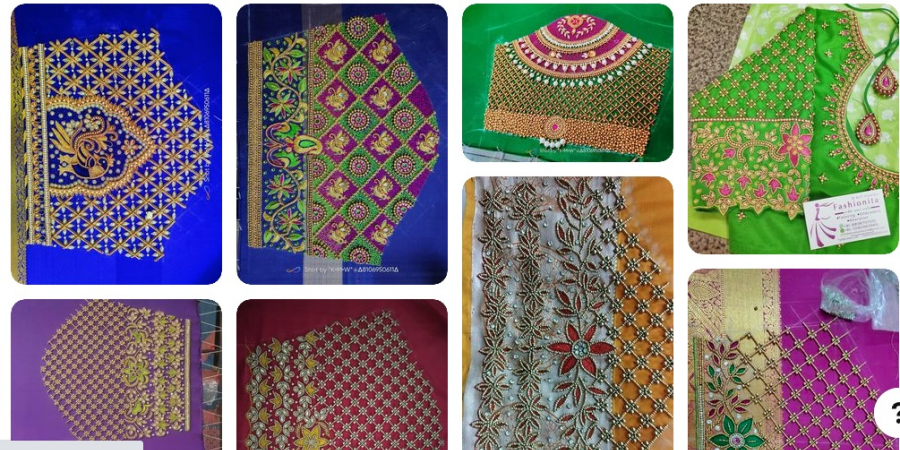

Numerous embroidery styles that differ by area and clothing style are practiced in India. Indian embroidery designs are created based on the fabric's texture, design, and stitching. The design is made up of the dot and the alternate dot, the circle, the square, the triangle, and various combinations and permutations of these.
In aari work, the material is laid out on a frame and a hook is plied from the top but fed by silk thread from below. This motion produces loops, and when these are repeated, a chain stitch line is produced.[1] The cloth is stretched over a frame, and the stitching is done with a long needle that ends in a hook, like a tambour (a needle with a sharp point that resembles a crewel), or Luneville work. In contrast to the conventional method of chain stitching, which involves feeding the thread from the underside and pulling it up with the hook, this method produces a chainstitch substantially faster: appears to be machine-made and can be adorned with beads and sequins, both of which are retained on the right side, and the needle enters their openings before descending to sew them to the material.Many materials are used, such as sequins, zari threads, and embellishments.
Many places around the world, including Kashmir[3] and Kutch (Gujarat), practice aari embroidery.*[4]
Banjara embroidery, a kind of Andhra Pradesh gypsy embroidery practiced by the Lambada[5] gypsy tribe, combines beadwork and applique with mirrors. Bands of vivid red, yellow, black, and white fabric are sewn together using a white crisscross stitch. The Madhya Pradesh Banjaras, who live in the districts of Malwa and Nimar, have their own embroidery technique in which geometric patterns and designs are embroidered using different colors and stitches to create a textured effect based on the cloth's weave. Cross-stitch typically highlights motifs.
The Lohana community is the primary practitioner of Heer Bharat, also known as Banni embroidery, which has its origins in Gujarat. Because it is made with silk floss—the word "Heer" means "silk floss"—it is renowned for having vivid color schemes and intricate design patterns, including shisha (mirror) work. The use of geometrical motifs and stitchery in Heer Bharat embroidery is influenced by the Punjabi bagh and phulkari embroidery.(6)
It began in the 17th century in the Himachal Pradeshi kingdom of Chamba. The princely hill states of Kangra,[7] Chamba, Basholi, and other nearby provinces were hubs for this embroidery. There are very talented craftspeople in the Chamba region. Chamba embroidery is a unique style of embroidery that uses untwisted silk threads to create small squares or rectangles on fabric.[8] Although most Chamba embroidery uses untwisted silk, some employ metallic yarn or thin metal wires.[9] Although the chamba rumal was created in the 17th century, it wasn't until the 18th century that it became widely known as a result of the patronage of Chamba Rumal embroiderers by Himalayan rulers.10] The original Chamba embroidery, which was created by women or small children, frequently featured gods or goddesses.(8) Marriages held great significance for the original Chamba embroidery as the The bride's dowry consisted of kept embroidery.In order to ensure superior quality work, many male painters drew the outlines and embroidered the clothing themselves during the Chamba embroidery craze of the 18th century, even though the original Chamba embroidery was created by women.(8) The chamba rumal saw a sharp fall in popularity not long after it peaked in the 18th century. The Chamba Rumals are not of the same quality as they were in the 17th and 18th centuries, and the rumals started to lose their sacredness. Today, the majority of rumals are made by families who are trying to sell them in order to survive.(8) Although this artistic movement has waned and nearly vanished over time, Lalita Vakil was awardedthe Shilp Guru award in recognition of her proficiency in Chamba embroidery.11]
